Timely tips for blending faith and life
Catholic All Week
Pope Francis held a special place in his heart for the Papal Basilica of St. Mary Major, one of five ancient basilicas in Rome and where he chose to be entombed. In his final testament, issued after his April 21 death, Pope Francis wrote, “I wish my last earthly journey to end at this very ancient Marian shrine where I would go to pray at the beginning and end of each apostolic journey to confidently entrust my intentions to the Immaculate Mother and to thank her for the docile and maternal care.” Why were Francis and seven other popes who are also buried there so attached to this church?
Snow in summer
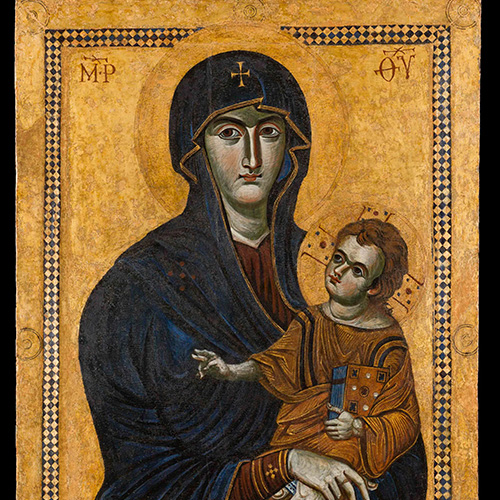 Around 350 A.D., a childless Roman couple wanted their wealth to honor the Blessed Virgin Mary after their deaths. According to legend, Mary appeared to the husband in a dream, requesting that a church be built on a site where snow would fall in midsummer. When the couple told Pope Liberius, he claimed to have had a similar dream. On Aug. 5, as Rome was engulfed in a heat wave, snow miraculously fell on the Esquiline Hill. On that spot a church was built and called the Liberian Basilica. While there is no historical evidence to support the legend – no mention of the story can be found until several hundred years after the church’s completion – the Miracle of the Snows is remembered each year in a liturgy that features white flower petals falling from the ceiling.
Around 350 A.D., a childless Roman couple wanted their wealth to honor the Blessed Virgin Mary after their deaths. According to legend, Mary appeared to the husband in a dream, requesting that a church be built on a site where snow would fall in midsummer. When the couple told Pope Liberius, he claimed to have had a similar dream. On Aug. 5, as Rome was engulfed in a heat wave, snow miraculously fell on the Esquiline Hill. On that spot a church was built and called the Liberian Basilica. While there is no historical evidence to support the legend – no mention of the story can be found until several hundred years after the church’s completion – the Miracle of the Snows is remembered each year in a liturgy that features white flower petals falling from the ceiling.
The icon by an evangelist
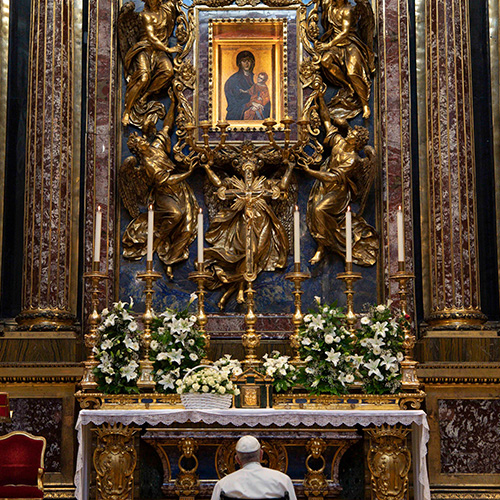 While the basilica houses many important relics – those of the true cross, holy crib, St. Matthew and St. Jerome – one of its most important pieces is an icon of the Blessed Virgin Mary. Legend claims the icon was “written” (painted) by St. Luke the Evangelist, but most scholars agree that it dates from the 13th century. Its name, “Salus Populi Romani” (“Health of the Roman People”), comes from a miracle in which the icon helped shield Rome from the plague after it was carried through the streets. In what was to become one of his most iconic moments, Pope Francis stood in an empty St. Peter’s Square on the rainy evening of March 27, 2020, as the COVID-19 pandemic began. Before the icon and the 14th-century statue of the “Miraculous Crucifix,” the Holy Father prayed for faith and strength for the world amid the crisis.
While the basilica houses many important relics – those of the true cross, holy crib, St. Matthew and St. Jerome – one of its most important pieces is an icon of the Blessed Virgin Mary. Legend claims the icon was “written” (painted) by St. Luke the Evangelist, but most scholars agree that it dates from the 13th century. Its name, “Salus Populi Romani” (“Health of the Roman People”), comes from a miracle in which the icon helped shield Rome from the plague after it was carried through the streets. In what was to become one of his most iconic moments, Pope Francis stood in an empty St. Peter’s Square on the rainy evening of March 27, 2020, as the COVID-19 pandemic began. Before the icon and the 14th-century statue of the “Miraculous Crucifix,” the Holy Father prayed for faith and strength for the world amid the crisis.
Where art and faith meet
 The basilica is often referred to as a place where the artistic and the spiritual meet. Rebuilt many times over the centuries, it features the tallest bell tower in Rome, mosaics that date from the early 400s, countless architectural details and the Holy Door that Pope Francis opened to celebrate the Jubilee Year 2025: Pilgrims of Hope. If you can’t get to the shrine, you can still take a realistic virtual visit through the basilica’s website.
The basilica is often referred to as a place where the artistic and the spiritual meet. Rebuilt many times over the centuries, it features the tallest bell tower in Rome, mosaics that date from the early 400s, countless architectural details and the Holy Door that Pope Francis opened to celebrate the Jubilee Year 2025: Pilgrims of Hope. If you can’t get to the shrine, you can still take a realistic virtual visit through the basilica’s website.
Catholic All Week
Following immediately after Easter Sunday is Divine Mercy Sunday, which has become one of the most treasured feasts of the Easter season. This year it is celebrated on April 27. But where did this relatively new (less than 100-year-old) feast come from, and how should you honor it?
Origins of the feast
 Mankind’s need for the message of Divine Mercy took on urgency in the early 20th century, when civilization began to lose respect for the sanctity and dignity of human life. In the 1930s, Jesus chose a humble Polish nun, St. Maria Faustina Kowalska, to receive private revelations about Divine Mercy that were recorded in her diary. This was at a time when St. John Paul II later noted the evil ideologies of nazism and communism were forming, calling Sister Faustina’s message that God is mercy the only truth capable of offsetting that evil.
Mankind’s need for the message of Divine Mercy took on urgency in the early 20th century, when civilization began to lose respect for the sanctity and dignity of human life. In the 1930s, Jesus chose a humble Polish nun, St. Maria Faustina Kowalska, to receive private revelations about Divine Mercy that were recorded in her diary. This was at a time when St. John Paul II later noted the evil ideologies of nazism and communism were forming, calling Sister Faustina’s message that God is mercy the only truth capable of offsetting that evil.
Papal connections
 On May 5, 2000, five days after the canonization of St. Faustina, the Vatican decreed that the Second Sunday of Easter would be known as Divine Mercy Sunday. In his second encyclical, “Rich in Mercy,” St. John Paul II offered an extended meditation on God’s mercy, which he calls “the greatest of the attributes and perfections of God.” He returned to this theme throughout his pontificate. John Paul II died in April 2005 on the vigil of Divine Mercy Sunday, was beatified on Divine Mercy Sunday, May 1, 2011, by his successor, Pope Benedict XVI, and was canonized on Divine Mercy Sunday, April 27, 2014, by Pope Francis.
On May 5, 2000, five days after the canonization of St. Faustina, the Vatican decreed that the Second Sunday of Easter would be known as Divine Mercy Sunday. In his second encyclical, “Rich in Mercy,” St. John Paul II offered an extended meditation on God’s mercy, which he calls “the greatest of the attributes and perfections of God.” He returned to this theme throughout his pontificate. John Paul II died in April 2005 on the vigil of Divine Mercy Sunday, was beatified on Divine Mercy Sunday, May 1, 2011, by his successor, Pope Benedict XVI, and was canonized on Divine Mercy Sunday, April 27, 2014, by Pope Francis.
How to pray the Divine Mercy Chaplet
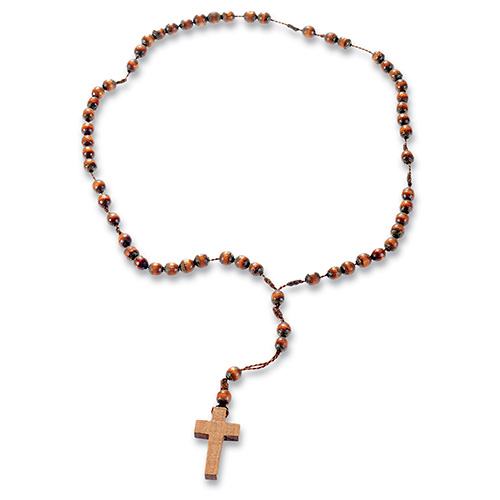 The Chaplet of Divine Mercy was given to St. Faustina with this promise: “Encourage souls to say the chaplet which I have given you” (Diary, 1541). “Whoever will recite it will receive great mercy at the hour of death. … Even if there were a sinner most hardened, if he were to recite this chaplet only once, he would receive grace from My infinite mercy. I desire that the whole world know My infinite mercy” (Diary, 687). The Divine Mercy Chaplet is prayed using a rosary:
The Chaplet of Divine Mercy was given to St. Faustina with this promise: “Encourage souls to say the chaplet which I have given you” (Diary, 1541). “Whoever will recite it will receive great mercy at the hour of death. … Even if there were a sinner most hardened, if he were to recite this chaplet only once, he would receive grace from My infinite mercy. I desire that the whole world know My infinite mercy” (Diary, 687). The Divine Mercy Chaplet is prayed using a rosary:
Step 1: Begin with the Sign of the Cross, then say one Our Father, one Hail Mary and the Apostles Creed. An optional opening prayer is: “You expired, Jesus, but the source of life gushed forth for souls, and the ocean of mercy opened up for the whole world. O Fount of Life, unfathomable Divine Mercy, envelop the whole world and empty Yourself out upon us.” Then repeat three times: “O Blood and Water, which gushed forth from the Heart of Jesus as a fountain of Mercy for us, I trust in You!”
Step 2: Then on the beads where with the rosary you would pray an Our Father, say the following: “Eternal Father, I offer You the Body and Blood, Soul and Divinity of Your dearly beloved Son, Our Lord Jesus Christ, in atonement for our sins and those of the whole world.”
Step 3: On each of the 10 Hail Mary beads, say the following: “For the sake of His sorrowful Passion, have mercy on us and on the whole world.”
Repeat steps 2 and 3 for all five decades.
Step 4: Conclude by saying the following three times: “Holy God, Holy Mighty One, Holy Immortal One, have mercy on us and on the whole world.” An optional closing prayer is: “Eternal God, in whom mercy is endless and the treasury of compassion inexhaustible, look kindly upon us and increase Your mercy in us, that in difficult moments we might not despair nor become despondent, but with great confidence submit ourselves to Your holy will, which is Love and Mercy itself.”
Catholic All Week
The liturgies for Holy Week are filled with beautiful Catholic traditions that reach back thousands of years. Good Friday is the only day of the year when the Church does not celebrate the Holy Sacrifice of the Mass. Instead, the Celebration of the Passion of the Lord consists of hearing the Passion reading from the Gospel of John, solemn intercessions, adoration of the cross and Holy Communion from hosts consecrated on Holy Thursday. Here is more about the tradition of adoration – or veneration – of the holy cross.
Where did it start?
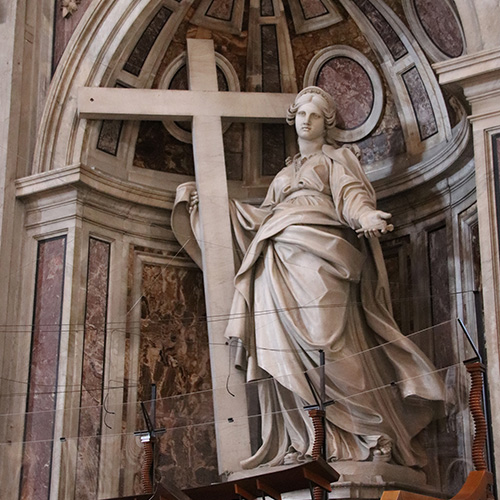 We have St. Helena, the mother of Roman emperor Constantine the Great, to indirectly thank for this tradition. She journeyed to Jerusalem in the fourth century to find the sites associated with Christ’s passion, with the primary goal of finding the true cross. What made this task more challenging was that over the centuries, the Romans had built over the places where Jesus was tried, sentenced and crucified. Helena excavated many sites before finding three crosses. According to legend, she touched a woman who was near death with parts of each of the crosses, and one – the true cross – healed her completely. Helena split that cross, leaving part in Jerusalem and taking part to Constantinople. Later, she took several pieces to Rome, where they were enshrined in the Basilica of the Holy Cross in Jerusalem.
We have St. Helena, the mother of Roman emperor Constantine the Great, to indirectly thank for this tradition. She journeyed to Jerusalem in the fourth century to find the sites associated with Christ’s passion, with the primary goal of finding the true cross. What made this task more challenging was that over the centuries, the Romans had built over the places where Jesus was tried, sentenced and crucified. Helena excavated many sites before finding three crosses. According to legend, she touched a woman who was near death with parts of each of the crosses, and one – the true cross – healed her completely. Helena split that cross, leaving part in Jerusalem and taking part to Constantinople. Later, she took several pieces to Rome, where they were enshrined in the Basilica of the Holy Cross in Jerusalem.
How do you adore the cross?
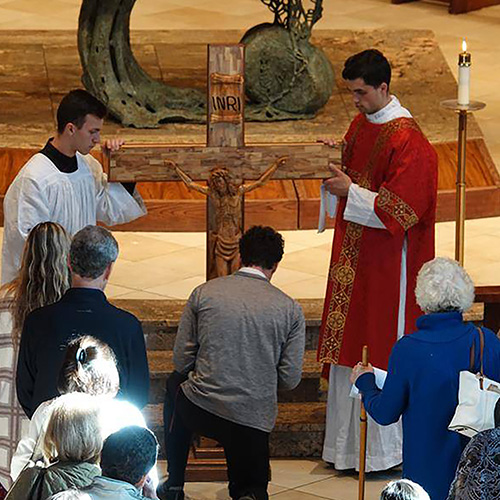 During the service, the priest unveils the cross that was previously shrouded. Alternately, a priest or a deacon can receive the unveiled cross and carry it in procession into the sanctuary. From there, worshipers are encouraged to come up individually, genuflect and kiss the cross as they recall Christ’s passion and sacrifice.
During the service, the priest unveils the cross that was previously shrouded. Alternately, a priest or a deacon can receive the unveiled cross and carry it in procession into the sanctuary. From there, worshipers are encouraged to come up individually, genuflect and kiss the cross as they recall Christ’s passion and sacrifice.
Can you adore the cross at home?
 While it can’t replace the communal experience of seeing the faithful approach and adore the cross, during COVID many Catholic entities created ways for the faithful to adore the cross at home. If you can’t get to church on Good Friday (which is not a Holy Day of obligation), you can still follow practices such as these from the Diocese of Corpus Christi that were adapted from The Catholic Company to give people a part of the experience at home. Begin by placing your most beautiful crucifix in a place of honor and light some candles by it. Kneel before the crucifix and spend time in prayer by thanking Jesus for his sacrifice, making an act of contrition, and saying The Prayer Before the Crucifix. Finally, kiss the crucifix.
While it can’t replace the communal experience of seeing the faithful approach and adore the cross, during COVID many Catholic entities created ways for the faithful to adore the cross at home. If you can’t get to church on Good Friday (which is not a Holy Day of obligation), you can still follow practices such as these from the Diocese of Corpus Christi that were adapted from The Catholic Company to give people a part of the experience at home. Begin by placing your most beautiful crucifix in a place of honor and light some candles by it. Kneel before the crucifix and spend time in prayer by thanking Jesus for his sacrifice, making an act of contrition, and saying The Prayer Before the Crucifix. Finally, kiss the crucifix.

